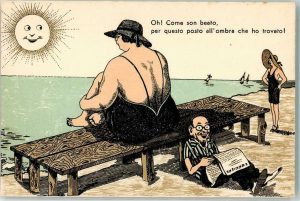Bob Teevan
Coming Modes
How It Will End?

This card was published by Valentine of Dundee as part of a set (perhaps more than one) that is aptly titled Coming Modes. There is no known evidence as to how many cards were issued in this set or these sets, although at least three others, Coming Modes, Coming Modes for Women, and Coming Modes for Men all are similar in style and the penmanship and humor appeal to a degree.
The stamp has been removed from this card although with the three other cards mentioned above having been postmarked in 1911, it may be that the same is true for this one.
The illustration shows a woman dressed in the fashion of the time, a harem skirt or jupe-culottes, and wearing a flamboyant hat with a feather – held in place by a hatpin. There is a certain irony in that ‘movement restricting’ harem skirt was considered to be liberating by women who were now casting aside traditional dresses and skirts.
It is true that many men were supportive of a woman’s right to wear such clothing, there were also those who saw it as a move by women to wear trousers, which would eventually grant them the same freedoms and rights as men. Where historically women have sought equality, men appear to have felt threatened by such movements. And naturally, a few men were content with women being the ‘fairer sex’ and the thought of them moving forward from the ‘domesticated partner’ status was not to be entertained.
As you will note the title of the card extends beyond Coming Modes for Women and concludes with or what it will end in. The artist has picked up on the concerns of some men that the freedom of dress is only a first step. The same men also question how far women will go with their equality demands. It could be that the artist – by hanging a parcel from the pin in the woman’s hat – is suggesting that a woman spends her husband’s money by shopping, and that not only is the woman a financial burden to the man, but she also seeks rights which will place her man in a subordinate role. Since the lady is depicted as standing on a trolley (potentially a pedestal) it suggests that the man is now obliged to pull her along the road of life.
It is interesting that when postcard artists seek to satirize the fashions of women, they depict these in reference to the middle class. At a time when the majority of those employed were men, it is more likely that the working-class man may have felt his status threatened. Not true here for it is a middle-class couple who are depicted.
These concepts – be they right or wrong – it doesn’t matter for the humor in how the fashion is depicted. It is sharp, clever, and amusing!

A Sidebar

How blessed I am for this place in the shade that I have found.
The card above comes from a sunny place on a Mediterranean beach. Its story reaffirms that the world has plenty of men who relish in the discomfort of others. In the climate of today’s world, they make sure the ideas set forth by the artist of the featured card is seldom challenged.

Bob is a great guy with a wonderful sense of humor. He paid me to say this.
I enjoy your post card website I had a friend who use to sell them at shows in Washington state 20 years ago
I doubt any artist of a hundred or more years ago predicted the typical women’s fashions of today!